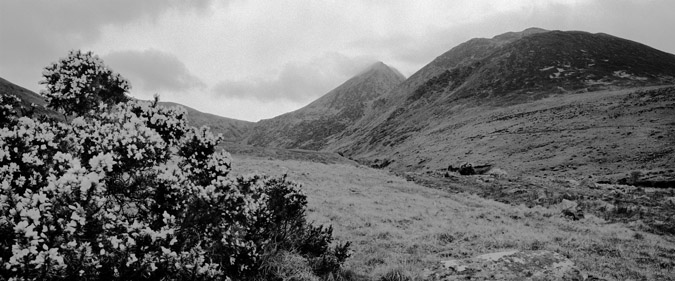‘You must go to Ireland’ and ‘you must go to New Zealand’. After hearing these words several times I was starting to get a complex; why did complete strangers want me to go so far away? My wife convinced me that they were just interested in buying my photographs and would like to see some from these, so far unvisited, places.
We decided to go to both, but a year apart. Further encouragement to visit Southern Ireland came with an enquiry from an existing customer, embarking on the 4 Peaks Challenge with three friends, wanting pictures of the 4 peaks (highest peaks in, Scotland, England Wales and Ireland) for all of them. I already had shots of Ben Nevis, Scafell Pike and Snowdon, but not the Irish one, Carrauntoohil in County Kerry. Emails confirmed the order and it just remained to go and take the picture and supply the 4 framed quartets in July. We decided on late April and to go with a couple of good friends such that the trip was a good mix of photography with local music and Guinness in the evenings!
The main objective was to photograph Carrauntoohil. The nearest town was Killarney so this became our base. I also knew that coastal areas like the Dingle Peninsula, and the cities of Cork and Dublin, plus the Liverpool skyline should give me sales and included these too.
Being a film photographer I wanted to go by car ferry to avoid airports (I have seen x-ray fogging on my 125 ISO film). We decided on a 6 day trip with 1 day at each end for ferry travel. This left us 2 full and 2 part-days in the mountains around Carrauntoohil. Not much spare time to play with should the weather be bad!
The ferry from Birkenhead to Dublin was booked at a bargain price as well as accommodation in Killarney, Cork and Dublin. Maps and guidebooks were purchased and time spent searching them, Google Images and Google Earth for an idea of possible images and locations for photographs.
For equipment, I took 3 medium format camera bodies, 2 wide angle lenses (43mm), plus 3 other lenses. I can’t afford to be let down by damaged camera gear and the Mamiya 7 is light; carrying a spare body and lens in a rucsac is not too much extra weight. The camera case I used was a Lowepro Specialist carried on the front using a shoulder harness and padded waist belt. The camera is always ready. The total weight of my photo kit was about 9 kg. Hill gear is extra!
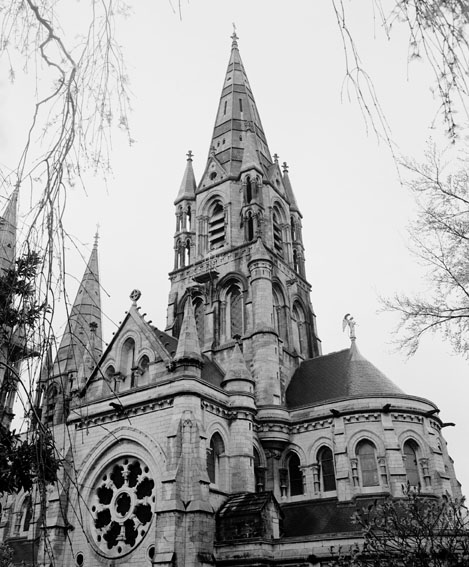
I use a tripod for every shot and feel as though I’m doing something wrong when not using one. This allows the use of slow shutter speeds with lenses stopped down for maximum depth of field. Carbon fibre tripods are perfect. They are light but sturdy, which is important when you have a bad back as I do. I use a small one for skiing and hard mountain days and a larger one for everything else.
It was dull as the ferry left Birkenhead, so no photos of Liverpool, and 7 hours later we were in Dublin. We reached our Cork hotel around midnight, 3 hours later than expected. The nextmorning was wet as I went around Cork taking churches and rivers in poor light.
It brightened up slightly so I went back and re-took some earlier shots.
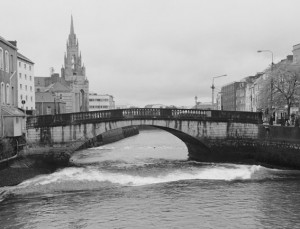
It looked promising as we drove west towards the mountains and the sky was great over some of the lower peaks and around the Gap of Dunloe (a popular tourist destination).
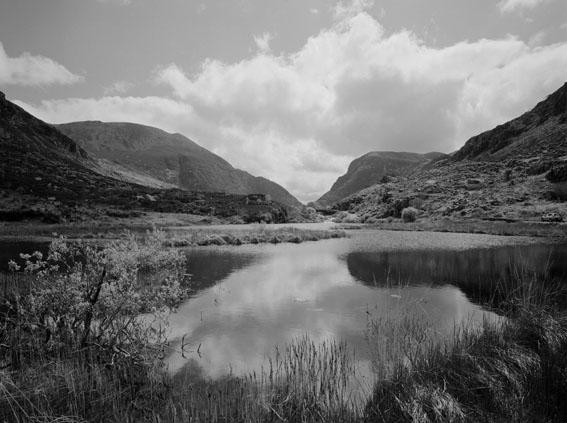 Next was the Black Valley to stretch our legs with an 8 mile walk. This runs south of Carrauntoohil and we had good views but the tops stayed in clouds.
Next was the Black Valley to stretch our legs with an 8 mile walk. This runs south of Carrauntoohil and we had good views but the tops stayed in clouds.
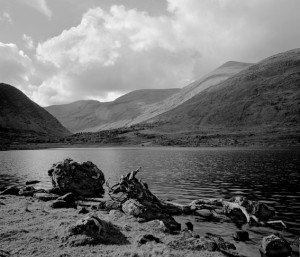
The next two days were pencilled in for Carrauntoohil. I wanted photographs from the top and from below and planned to climb it by a narrow ridge from the west for spectacular views to the summit and the coast. Unfortunately, the wind was too strong, 25 mph in the car park meant gales on the tops. We diverted to Seefin, a few miles away and 2000 feet lower. If it cleared we would have views to Carrauntoohil, if not it was a good walk with coastal views.
The rain continued so we walked around, rather than up, the peak and then came to a pub and an excuse to get out of the rain! Eventually the rain stopped and we left to climb Seefin in winds gusting 60 mph. Coastal photographs from the lower slopes and boats on a small lake in the valley gave me something from the day.
The following day was brighter and less windy so we decided to use the safer route up Hags Glen. At breakfast one of our friends said that she didn’t like the look of the weather through the window and our landlady replied ‘if you don’t like the weather through that one then look out of another window’. The power of positive thinking!
We drove to the car park where I jumped out with my camera and quickly made my way up the track. The summit was visible although clouds were swirling around. I grabbed a shot with some gorse in the foreground and then jogged uphill towards a river marked on the map, trying to find something better before it closed in.
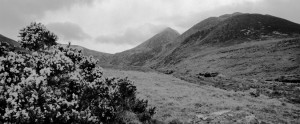
Small falls gave a better foreground and the sixteen foot high summit cross could be seen for a few minutes before it started to rain. I knew I had useable shots of Carrauntoohil now; quite a relief, minutes later and I would have missed it.
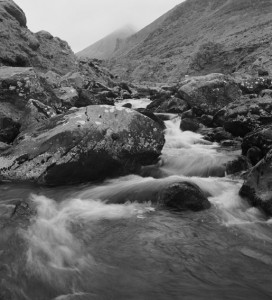
The steep trail up Devils Ladder had become a waterfall from the heavy rain, with sleet and strong winds on the summit preventing shots here. The rain eased as we returned to the bottom and I spotted a waterfall near the track.
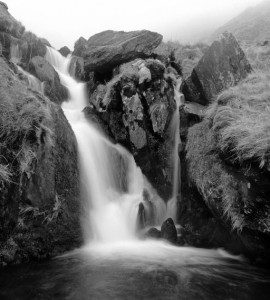
Several photos later the rain increased preventing me from changing the film and taking more.
The next day was showery with clouds on the big peaks; it was time for some coastal shots.
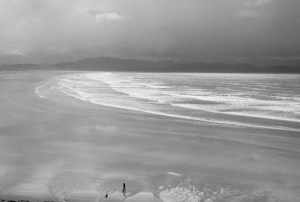
We drove down the Dingle Peninsula to Slea Head in sunshine with rain and hail showers.
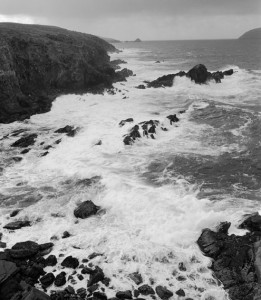
Spectacular weather for photographers as long as you weren’t caught in the open!

Several films later we headed back to Dublin, arriving mid evening for night shots.
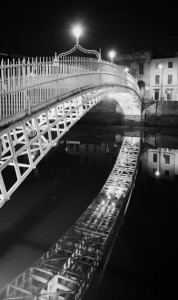
We went to the bridges and old town, finishing around midnight and joined our friends in Gogarty’s music bar for a nightcap.
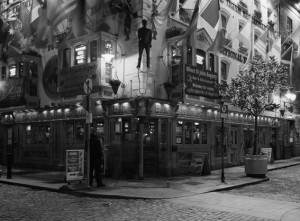
To round things off I was able to take the Liverpool skyline from the ferry as we arrived back in Birkenhead.
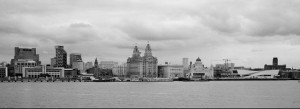
Overall, it was a successful trip. The main objective was met as well as others but it was disappointing that Carrauntoohil was only out of the clouds for a total of 20 minutes in 4 days, no matter which window I looked out of!
Summary
- Check out area on web – look for images, events, iconic views.
- Confirm dates and place.
- For landscapes, look at Google Earth to check out the lie of the land. Click icons to see photos that others have taken, bear in mind that many are from mobile phone cameras!
- Buy maps, and guidebooks with pictures. Look for viewpoints marked on maps. Make sure you know how to use maps and a compass to stay safe in bad weather.
- Pull together a rough plan of what to do including must-do locations, and a prioritised list of images that you would like to take – both specific and general.
- Check local photography restrictions on the web before leaving!
- Look at travel options, including special deals, and book.
- Plan activities for each day using maps and guidebooks but leave time spare in case of poor weather and for changes in plan.
- Book accommodation to fit itinerary.
- Pull together a kit list so that you don’t leave behind anything important, like your passport! Practice packing everything to make sure you meet weight limits for airline hand and hold luggage and keep a note of what goes where.
- Look at local postcards and books in your accommodation and local shops to give you further inspiration.
My Equipment
- Mamiya 7 cameras x 3; 43 mm lens (with viewfinders) x 2, 65, 80, 150 mm lenses
- Gitzo GT1541 and 1028 carbon fibre tripods, Gitzo GH1780QR and Manfrotto 486RC2 tripod heads (and spare quick release plates)
- Ilford FP4 Plus 120 film x 60 rolls, Ilford SFX 120 x 16 rolls, all in Ortlieb strong clear plastic cases to aid customs examination
- Sekonic L-508 light meter
- Filters: B+W & Heliopan, yellow, dark yellow, orange, UV, Heliopan 715 IR, Cable releases x 2
- Lowepro Specialist and Film Drop cases, with shoulder harness and padded waist belt,
- Mountain rucsac, 35 litre, waterproof rucsac liner bag, trekking poles x 2, Maps, waterproof map case, compass, gps, anemometer (to measure wind speed), LED head torch.
- Spare batteries: camera, light meter, torch, gps
- Walking boots, waterproof jacket & trousers, warm layers x 3, warm hat, gloves, sun hat, sun glasses (last two not used!).
- Blackberry for email, texts, mobile phone calls, web browsing.
- Power Monkey to recharge Blackberry anywhere, even on mountains using solar panel.
- Travel and equipment insurance details, passport, driving license
Bad Weather Options
If the weather is too bad for taking photographs then wrap the camera in a waterproof bag and wait for the rain to stop! Alternatively, go somewhere sheltered, such as woodland (or indoors!), and look for smaller cameo shots rather than big views. Make sure the lens is clear of rain drops (or snow) before pressing the shutter button. Use a large umbrella to shelter the camera from the elements.
Waterfalls can be at their best while it is raining; you must be quick to avoid the camera getting waterlogged. If all else fails go to the pub but keep an eye on the weather outside.
